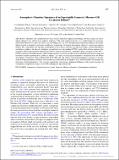Atmospheric Chemistry Signatures of an Equatorially Symmetric Matsuno–Gill Circulation Pattern
Author(s)
Wilka, Catherine Anne; Solomon, Susan; Cronin, Timothy Wallace; Kinnison, Doug; Garcia, Rolando
DownloadPublished version (1.953Mb)
Publisher Policy
Publisher Policy
Article is made available in accordance with the publisher's policy and may be subject to US copyright law. Please refer to the publisher's site for terms of use.
Terms of use
Metadata
Show full item recordAbstract
© 2020 American Meteorological Society. For information regarding reuse of this content and general copyright information, consult the AMS Copyright Policy (www.ametsoc.org/PUBSReuseLicenses). Matsuno-Gill circulations have been widely studied in tropical meteorology, but their impact on stratospheric chemistry has seldom been explicitly evaluated. This study demonstrates that, in a model nudged to reanalysis, anticyclonic Rossby wave gyres that form near the tropopause as a result of equatorially symmetric heating in the troposphere provide a dynamical mechanism to influence tropical and subtropical atmospheric chemistry during near-equinox months. The anticyclonic flow entrains extratropical air from higher latitudes into the deep tropics of both hemispheres and induces cooling in the already cold upper-troposphere/lower-stratosphere (UTLS) region. Both of these aspects of the circulation allow heterogeneous chlorine activation on sulfuric acid aerosols to proceed rapidly, primarily via the HCl 1 ClONO2 reaction. Precipitation rates and heating rates from reanalysis are shown to be consistent with these heating and circulation response patterns in the months of interest. This study analyzes specified dynamics simulations from the Whole Atmosphere Community Climate Model (SD-WACCM) with and without tropical heterogeneous chemistry to demonstrate that these circulations influence substantially the distributions of, for example, NO2 and ClO in the UTLS tropics and subtropics of both hemispheres. This provides a previously unrecognized dynamical influence on the spatial structures of atmospheric composition changes in the UTLS during near-equinox months.
Date issued
2021Department
Massachusetts Institute of Technology. Department of Earth, Atmospheric, and Planetary Sciences; Massachusetts Institute of Technology. Department of ChemistryJournal
Journal of the Atmospheric Sciences
Publisher
American Meteorological Society